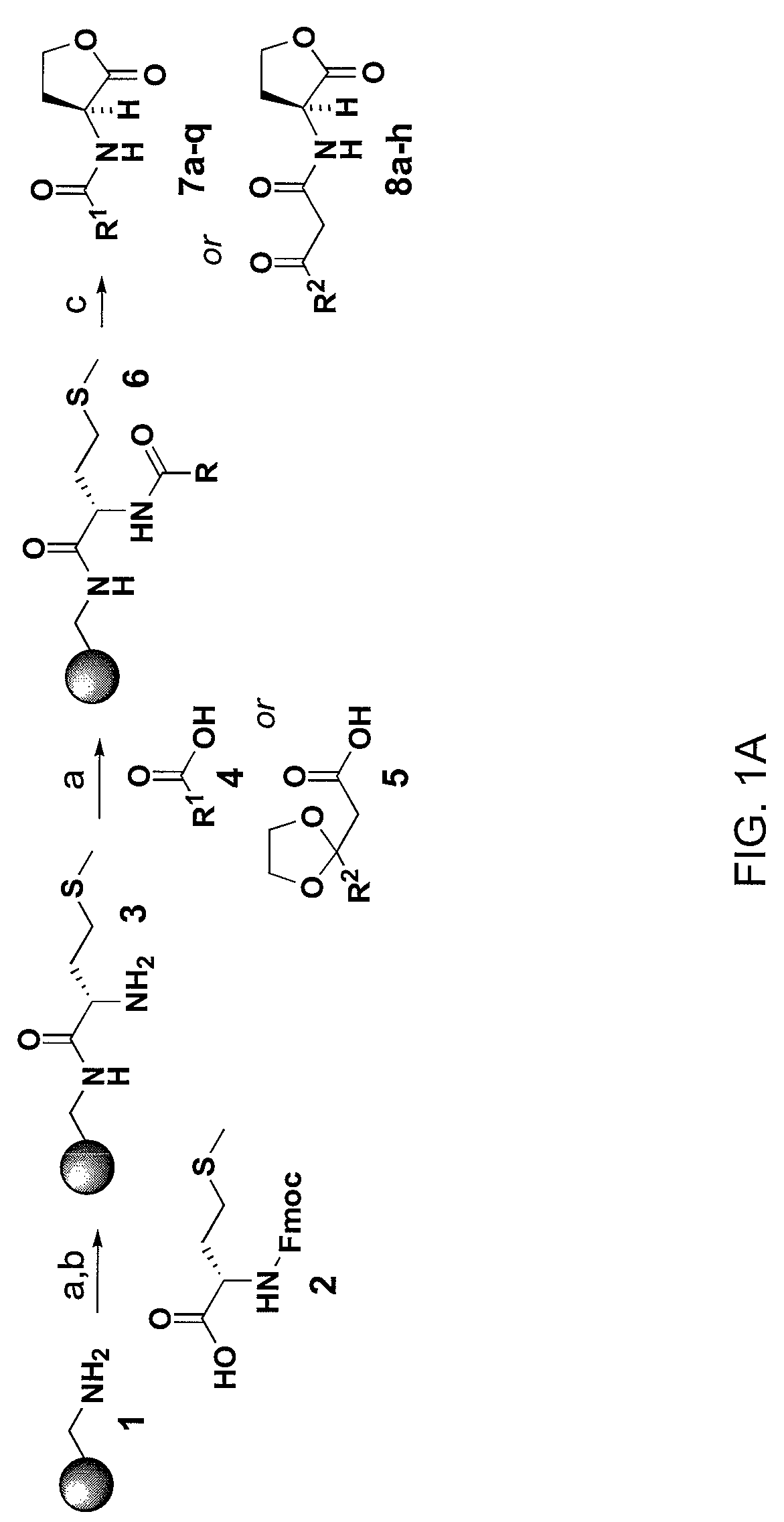Compounds and methods for modulating communication and virulence in quorum sensing bacteria
a technology of quorum sensing and molecules, applied in the field of molecules and methods for modulating quorum sensing in bacteria, can solve the problem that the use of combinatorial methods to systemically evaluate ahl analogs remains essentially unexplored, and achieves high purity and yield
- Summary
- Abstract
- Description
- Claims
- Application Information
AI Technical Summary
Benefits of technology
Problems solved by technology
Method used
Image
Examples
example 1
Synthesis of 3-Oxooctanoic Acid (10b) (SCHEME IV)
[0123]A stirred solution of bis-trimethylsilyl malonate (21.6 g, 71.5 mmol) in 100 mL of anhydrous diethyl ether was cooled to −78° C. To this solution, n-butyl lithium (1.6 M in ether, 44.7 mL, 71.5 mmol) was added slowly, keeping the temperature below −60° C. Upon completion of addition, the reaction was allowed to warm to −10° C., at which time hexanoyl chloride (5 mL, 35.75 mmol) was added quickly and allowed to stir for 30 minutes. Next, 150 mL of a cold, aq. 5% sodium bicarbonate solution was added, and the resulting solution was stirred vigorously for 30 minutes. The aq. layer was separated out and acidified with cold 4N sulfuric acid until pH=2. The aq. layer was then extracted 2×50 mL with diethyl ether, dried over MgSO4, and concentrated down in vacuo to afford a white solid. This solid could be further purified by recrystallization from hexane, if necessary. 4.9 g, 87% yield. 1H NMR (300 MHz, CDCl3) δ=3.49 (s, 2H, CH2), 2.5...
example 2
Synthesis of Methyl-3-Oxooctanoate (11b) (SCHEME V)
[0125]To a stirred solution of 10b (5.5 g, 35 mmol) in 150 mL of a 4:1 mixture of benzene and methanol, TMSCHN2 in diethyl ether (2M, 21 mL, 42 mmol) was added over a period of 10 minutes. The reaction was allowed to stir for 30 minutes, after which the reaction mixture was concentrated in vacuo to afford 11b as a yellow oil. This material was used in the subsequent step (SCHEME IV) with no further purification. 6.1 g, 95% yield. 1H NMR (300 MHz, CDCl3) δ=3.73 (s, 3H, CH3) 3.44 (s, 2H, CH2), 2.55 (t, 2H, J=7.3 Hz, CH2), 1.64 (p, 2H, J=7.4 Hz, CH2), 1.36 (m, 4H, CH2CH2), 0.91 (t, 3H, J=6.9 Hz, CH3); 13C NMR (75 MHz, CDCl3) δ=202.9, 167.9, 128.5, 52.7, 49.2, 43.2, 31.3, 23.3, 14.0 ppm.
[0126]
example 3
Synthesis of 3,3-Ethylenedioxooctanoic Acid (5b) (SCHEME VI)
[0127]To a stirred solution of methyl-3-oxooctanoate (11b) (5.6 g, 32.5 mmol) in 125 mL of benzene, ethylene glycol (20.2 g, 325 mmol) and pTsOH (0.617 g, 3.25 mmol) was added. The flask was equipped with a condenser and Dean-Stark trap and heated to reflux for 24 h. The reaction mixture was concentrated in vacuo and diluted in 100 mL of diethyl ether. The organic layer was washed with 2×25 mL of 10% aq. NaOH, then 2×25 mL of saturated NaCl solution, dried over MgSO4, and concentrated in vacuo to afford a clear oil. This oil was subjected to saponification by treatment with 1N NaOH (150 mL) and MeOH (75 mL) for 6 h. The basic solution was concentrated in vacuo, chilled in an ice bath, and acidified with cold concentrated HCl to a pH=2. The acidified solution was extracted with 2×75 mL of diethyl ether, dried over MgSO4, and concentrated in vacuo to afford 3,3-ethylenedioxooctanoic acid 5b as a clear oil. 3.3 g, 50% yield. 1...
PUM
| Property | Measurement | Unit |
|---|---|---|
| temperature | aaaaa | aaaaa |
| power | aaaaa | aaaaa |
| temperature | aaaaa | aaaaa |
Abstract
Description
Claims
Application Information
 Login to View More
Login to View More - R&D
- Intellectual Property
- Life Sciences
- Materials
- Tech Scout
- Unparalleled Data Quality
- Higher Quality Content
- 60% Fewer Hallucinations
Browse by: Latest US Patents, China's latest patents, Technical Efficacy Thesaurus, Application Domain, Technology Topic, Popular Technical Reports.
© 2025 PatSnap. All rights reserved.Legal|Privacy policy|Modern Slavery Act Transparency Statement|Sitemap|About US| Contact US: help@patsnap.com



